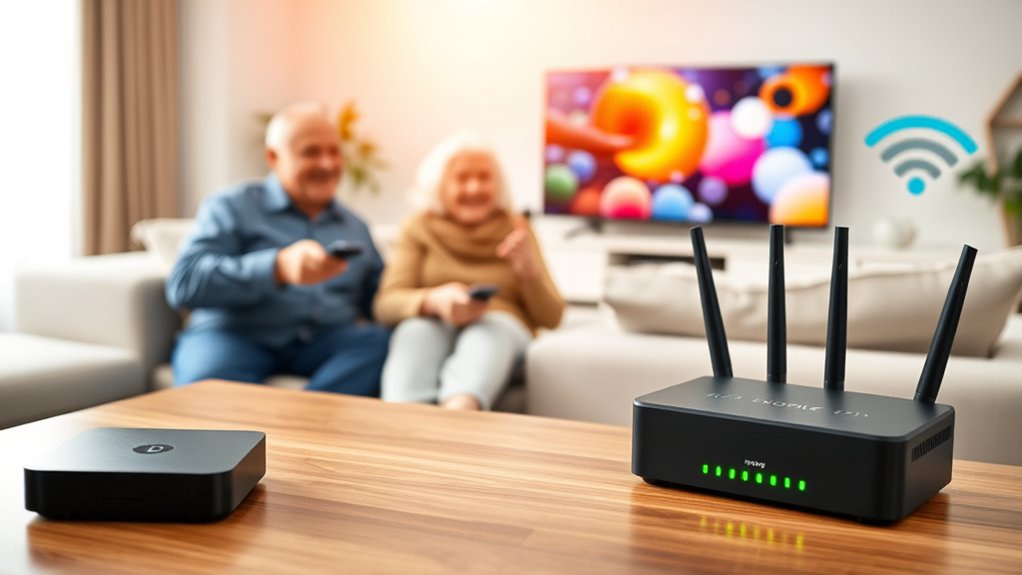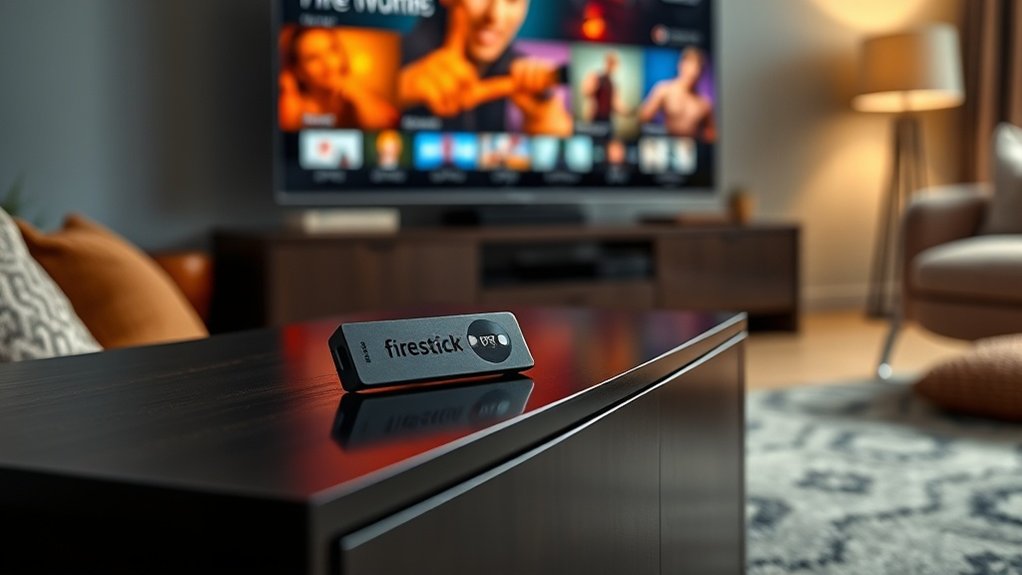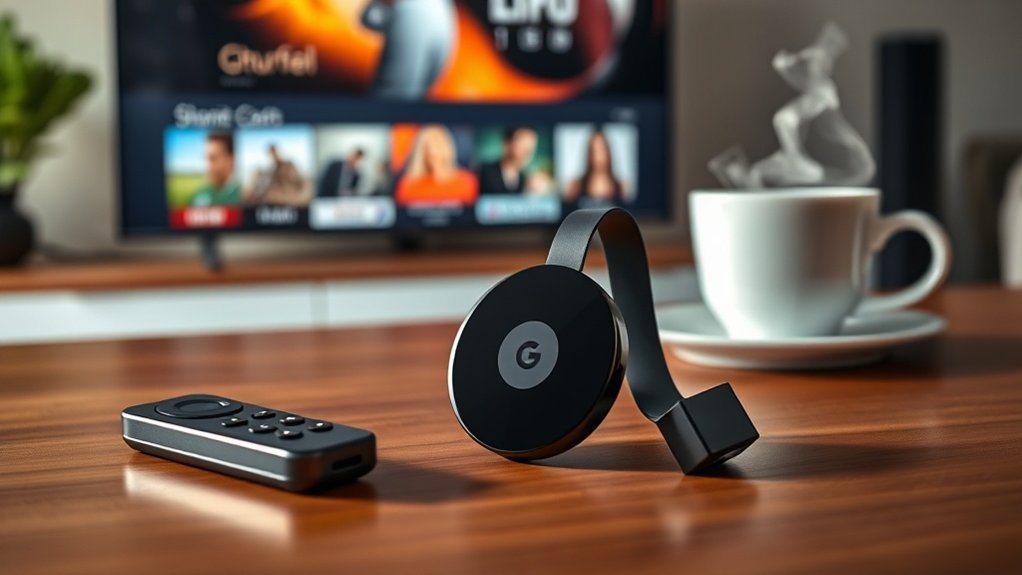When picking a streaming device for seniors, it’s essential to reflect on their specific needs. Start with user-friendly devices like Roku, featuring large icons and simple menus. Simplified remote controls with big buttons and voice features can make maneuvering a breeze. Don’t forget accessibility options, like closed captioning, to guarantee everyone enjoys the content. Plus, solid internet and performance are key—nobody likes buffering, right? If you’re interested in more insightful tips to simplify streaming, keep investigating!
Key Highlights
- Select devices with large icons and simplified menus for easy navigation and reduced overwhelm.
- Choose remotes that have large, tactile buttons and minimalistic layouts to enhance usability.
- Look for streaming platforms that allow adjustable text sizes, closed captioning, and voice control features.
- Ensure a reliable internet connection, aiming for speeds of at least 25 Mbps for smooth streaming.
- Investigate accessibility features like high-contrast displays and screen readers for improved user experience.
Understand Your Needs and Preferences
When you’re thinking about streaming devices for seniors, it’s crucial to understand your unique needs and preferences to guarantee a seamless experience.
Start by evaluating visual accessibility—those larger screens and high-contrast displays make navigation much easier. If you or someone you’re helping has hearing impairments, look for devices with adjustable volume and the option for subtitles. Additionally, consider that adults aged 65 or more maintain a strong preference for traditional TV, which may influence their comfort with transitioning to digital devices. Moreover, a reliable Wi-Fi connection is essential for seamless online access, ensuring that streaming is uninterrupted and enjoyable.
Evaluating visual accessibility is key; larger screens and high-contrast displays can make streaming much easier for seniors.
Don’t forget about navigation; simple menus cut down on confusion, as voice control can be a lifesaver for those with physical limitations.
Finally, choose remotes with big buttons, since nobody wants to wrestle with tiny controls. A little thought into these areas can transform streaming into a genuinely enjoyable pastime, not a technology-induced headache, right?
Choose User-Friendly Devices
Choosing user-friendly devices is vital for making streaming an enjoyable experience, particularly for seniors, as it eliminates unnecessary frustration and confusion.
Look for options with large, clear icons and simplified menus that don’t overwhelm with too many choices. For instance, streaming platforms like Roku offer layouts designed specifically for easy navigation. Additionally, consider devices that emphasize easy navigation, as this feature significantly improves the overall user experience. Many seniors appreciate the large buttons on Roku remotes that claim to simplify the viewing experience.
Consider devices with adjustable text sizes and features like closed captioning—these can be real game-changers for accessibility.
In addition, aim for systems that won’t require complicated setups or multiple steps to get started. After all, who needs the hassle?
Look for Simplified Remote Controls

Finding a simplified remote control can be one of the easiest ways to improve the streaming experience for seniors, especially when it often feels like remotes have too many buttons for any human to comprehend.
Look for remotes with large, tactile buttons that boost usability—these features make it easier for those with vision impairments or dexterity issues. Color-coded and high-contrast labels help lessen confusion, almost like a cheat sheet for channels. Additionally, the Flipper Big Button Remote is specifically designed with seniors in mind to enhance their television experience.
Moreover, universal remotes reduce clutter by controlling multiple devices, which means fewer remotes to juggle. If you want to avoid button overload, opt for minimalist layouts that highlight crucial functions.
And if voice control catches your fancy, it can turn streaming into a true hands-free affair—no more squinting or fumbling!
Explore Accessibility Features
Investigating accessibility features is essential for making streaming more enjoyable and inclusive, especially for seniors who might face various challenges during maneuvering technology.
Most streaming platforms offer closed captioning, enhancing watching experiences for those with hearing loss; you can even customize font size and color for better visibility. If you’re worried about steering through menus or selecting shows, many devices include voice control features that let you search by simply speaking commands—no need to wrestle with remote buttons.
Plus, high-contrast display modes cater to varying visual needs, ensuring clarity. With screen reader capabilities, texts can be read aloud, guiding you step by step (because who needs to squint, right?).
Embracing these options can truly transform your streaming adventures.
Ensure Reliable Performance

In relation to smooth streaming experiences, ensuring reliable performance can be the difference between blissful binge-watching and frustrating freezes.
First, choose devices like Roku or Amazon Fire Stick, known for their rock-solid hardware and software stability. These devices often receive regular updates to stave off annoying bugs.
You’ll additionally want a stable internet connection—ideally, Wi-Fi at 5 GHz or a wired Ethernet line, with speeds of at least 25 Mbps for seamless HD viewing.
To improve your experience further, select devices with clean, minimal interfaces that keep system responsiveness high.
Finally, keep in mind that regular reboots and routine maintenance can work wonders, much like giving your car an oil change to prevent breakdowns. Additionally, consider using Bluetooth speakers such as the JBL Flip 6 for an enhanced audio experience while streaming your favorite shows.
Who wants interruptions during the latest must-see series?
Consider Content Availability and Ecosystem
As you guarantee reliable performance is definitely important, the content you can access and the ecosystem it fits into can make or break your streaming experience.
You’ll want to contemplate platforms that offer a diverse library, filled with documentaries, classic movies, and comedies—content that resonates with your interests or nostalgia.
Plus, the integration of these services with familiar devices, like smartphones or smart TVs, simplifies things. If your platform connects cohesively with voice assistants, managing your viewing can be as easy as a simple command.
Think of ecosystems as helpful guides, steering you toward your favorite shows without a maze of menus. After all, who’s the time for that, right?
Enjoying what you love should be the priority!
Take Advantage of Support Resources
As you navigate the world of streaming technology, it might seem intimidating at first, but taking advantage of the available support resources can greatly ease the process and boost your confidence.
For instance, many streaming platforms and TV service providers offer dedicated hotlines tailored for seniors, providing expert guidance customized to your needs. Joining community technology classes can help too, allowing you to learn alongside peers and make new friends during device navigation.
Plus, user-friendly tools like simplified remote controls can make things even easier!
User-friendly innovations, such as simplified remote controls, enhance the streaming experience and boost accessibility.
And don’t overlook online communities, where you can connect with fellow seniors who share tips and experiences.
Frequently Asked Questions
What Streaming Services Are Most Popular Among Seniors?
In terms of streaming services, seniors often favor Netflix for its classic films, Amazon Prime Video for affordability, and Hulu for live TV options, all offering diverse content that meets your viewing preferences.
Can I Watch Live TV With Streaming Devices?
Yes, you can watch live TV with streaming devices. Just connect your device to the internet, subscribe to a live streaming service, and install the apps. Enjoy real-time broadcasting from various channels without traditional cable.
Are There Warranties for Streaming Devices?
Yes, most streaming devices come with manufacturer warranties lasting about a year, covering defects. You should check the specific terms, as coverage excludes accidental damage and may include additional options like extended warranties for better protection.
How Do I Connect Streaming Devices to My TV?
To connect your streaming device, plug it into an available HDMI port on your TV, power it on, then switch the TV input to that port. Follow on-screen instructions to complete the setup.
What Is the Average Cost of Streaming Subscriptions?
The average cost of streaming subscriptions varies, typically ranging from $7 to $10 per month for individual services. Many households subscribe to about four services, spending roughly $42 to $61 monthly on streaming.




